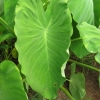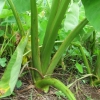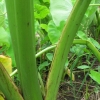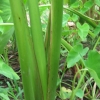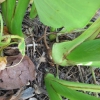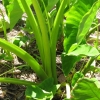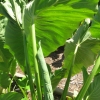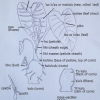Use As Food
Good as poi, but not used often because the ‘i‘o kalo (Corm) are usually small. The leaves (lū ‘au) are cooked. The leaf was preferred by some kupuna for its tenderness and there are those who still remember having to gather in the mountains for their parents as part of their chores. Maybe when ‘Āweu grew under the canopy of the trees in the uplands it made the leaf softer. The same plant in full sun has a much tougher leaf.
Distribution
Formerly widely distributed in wild state, now scattered along streams and in forests in the mountains. ‘Āweoweo preferred the wet uplands but can be found from wet to mesic forests, meaning a balanced supply of rain, except where pig populations are high. Pigs dig up everything.
General Characteristics
Medium in height to tall, moderately spreading, maturing within 9 to 12 months, producing from 10 to 15 long, slender rhizome (corm); distinguished by length of rhizome (corm).
Ha (Petiole)
70 to 105 cm. long, light green often inconspicuously flecked with dark green near kōhina (base), white at kōhina (base), with narrow, light purplish to indistinct edge, curved sharply at apex so that blade hangs vertically.
Lau or Lu'au(Leaf Blade)
40 to 65 cm. long, 25 to 45 cm. wide, 35 to 55 cm. from tip to base of sinus, narrowly egg-shaped (ovate), thin in texture, light green; margins slightly wave-like (undulate); piko greenish to faintly purple; round leaf section (lobes) acute with shallow, narrow lihi māwae (sinus).
'I'o kalo (Corm)
Flesh white with yellowish fibers; skin cream-colored, usually with pink or purple along leaf-scar rings, the outer skin shaggy and fibrous.
Pua (Flower)
Remarks
This variety was used by the Hawaiians for poi only when other food was scarce. The ‘i‘o kalo (Corm) are too acrid to be used as table taro unless cooked for a long time. ‘Āweu is often called wild taro because of its frequent occurrence in the wild state. The rhizome (corm), sometimes as long as 70 cm., come so close to the surface that they appear like creeping ‘ohā (stolon - a shoot that grows horizontally).

